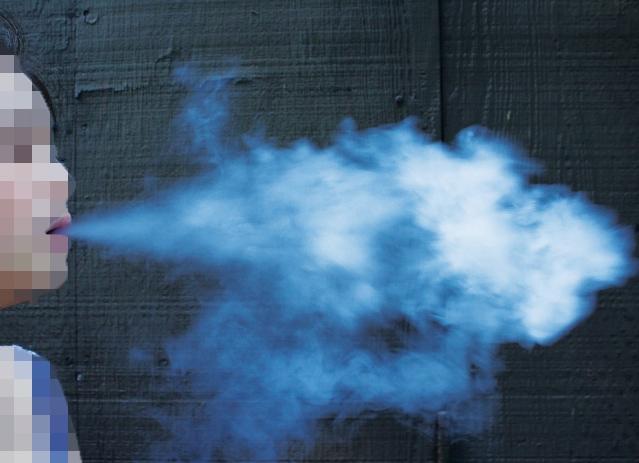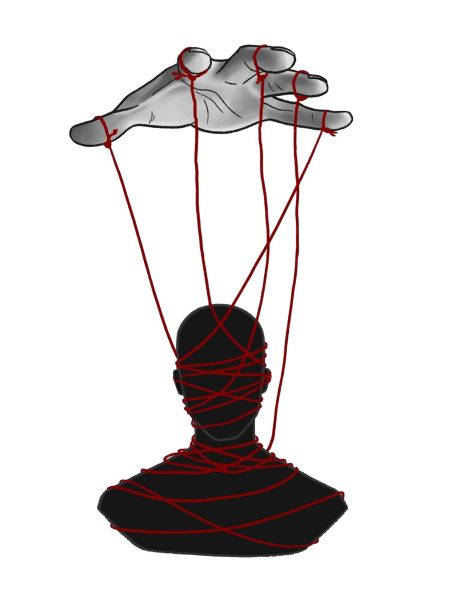JUUL: the modern cigarette
June 1, 2017
You begin to notice a fuzzy feeling in your head. A feeling that makes you want to relax, a feeling that may make your body hot or cold, a feeling that many Redwood students have become addicted to: the feeling of hitting the JUUL.
Anonymous junior “Hailey” bought her first JUUL sophomore year. She consistently took “mokes” (a marijuana and tobacco mixture smoked out of a bong) at the time and liked the similar headrush the JUUL gave her.
She was first introduced to the JUUL by her best friend.
The JUUL is a thin black vaporizer that comes with prepared cartridges containing nicotine, chemicals and various flavors. Produced by Pax Labs in San Francisco, it has become increasingly popular among Redwood students. According to a February Bark survey, 87 percent of Redwood students know what a JUUL is. Eleven percent of people surveyed, or a projection of 200 students, reported using a JUUL at least once a week.
The JUUL itself, a $49.99 purchase, comes in a “starter-kit” with the device, a charger and one JUULpod of each flavor. In order to use the JUUL, a JUULpod containing the substance that produces the vape cloud is placed into the top of the JUUL. The JUULpods come in five flavors: tobacco, mint, fruit medely, creme brulee and mango. Each JUULpod pack costs $15.99.
The JUUL is an easy, convenient vape for teens to use. Unlike other vapes that require users to mix their own juices and create their own flavors, the JUULpods are premade.
Although the JUUL company states how much nicotine each pod contains on their JUUL website, the true amount is unknown as it is not regulated by the Food and Drug Administration (FDA.)
“Unlike cigarettes, e-cigarettes and Juuls are not FDA controlled yet, so all of those liquids, say they have 5 mg of nicotine, or 5 percent nicotine, but there is no way to verify it because it is not FDA regulated yet,” said UCSF School of Medicine Professor Mark Rubenstein.
“The FDA is going to regulate it, they just haven’t yet. So, it could be 10 percent or 0 percent nicotine, which is a little scary.”
According to the JUUL website, each pod contains 5 percent nicotine by weight and is equivalent to one pack of cigarettes or 200 puffs.
“The nicotine doses are pre-adjusted. I bet a lot of teenagers like that because they don’t have to think about it…,” Rubenstein said.
Hailey uses the JUUL throughout the day, in the bathroom and off campus.
“Whenever it’s charged throughout the day I use it pretty consistently, whether it’s my friends using it or me,” Hailey said.
Usually when Hailey takes a hit from her JUUL, other friends or peers will ask if they can also have a hit and it will be passed around.
“I feel like a lot of people just do what other people do, so if someone has it someone else will ask to try it and that is kind of how it got spread around,” Hailey said.
Hailey has never gone through an entire pod by herself, but by sharing her Juul with others she can easily finish one pod in a day.
Despite her frequent usage, Hailey is extremely fearful of the health risks associated with the JUUL.
“[The health risks] scare me so much. I feel like it is just Chinese chemicals. I feel like it is just so bad for me, yet it is just addicting,” Hailey said.
One of Hailey’s greatest concerns is the amount of nicotine the pods contain.
“At our age, being so young, it is probably not good for us to be having that amount of nicotine,” Hailey said. “The level of nicotine is so high and the amount of pods that we go through in a week is just so shocking.”
Hailey herself has thrown up after hitting the JUUL too many times and has also had a seizure after taking a moke. She believes both of these reactions were caused by nicotine.
“It’s just way too much nicotine for our bodies and it’s not healthy,” Hailey said. “It really sketches me out.”
The first time Hailey hit the JUUL she instantly got a head rush after one hit and felt like the chemicals were altering her brain. Now, after one hit she feels nothing at all.
“If I hit it five times in a row without breathing in-between then I will get a head rush. I definitely have a massive tolerance to it,” Hailey said.
This change in Hailey’s tolerance has caused her to only use the JUUL for the taste and the different flavors rather than the feeling of getting a head rush.
“I’ve considered stopping a lot, but something about the taste just makes me want to keep using it,” Hailey said.
Hailey said that even if serious health notices were released about the JUUL, she would only stop using the JUUL if she could find another alternative that has a similar flavor in order to stop.
“I’ve been thinking about [stopping] for a while now, it’s just more about getting myself to actually stop and it’s kind of hard at Redwood just because everyone uses it and it is such a widespread thing in Marin,” Hailey said. “As much as I want to stop, I just feel like it is so difficult to when you have all the resources around you and everything you could possibly need to [continue].”
Anonymous junior “Jimmy” was first introduced to the JUUL when he was a sophomore, but had no interest in using it until just a few months ago. Jimmy bought the JUUL at a store in San Francisco.
“Once I started using it, I did some research and saw that it is a little bit healthier than using tobacco,” Jimmy said. “Then it was like, ‘Oh I’m not going to use it for the hype, I’m going to use it to not smoke actual tobacco or chew tobacco.’”
Jimmy believes the JUUL is healthier for his lungs because rather than containing tobacco, it contains vaporized smoke with nicotine.
“It’s healthier than cigs and dip,” Jimmy said.
Professor Neal Benowitz, who specializes in human pharmacology of nicotine at the UCSF School of Medicine, has found that the chemicals in e-cigarettes and vaporizers are not as harmful as the chemicals found in traditional cigarettes, but he still does not know how much injury the chemicals cause.
“The presence [of chemicals] for the most part are in small concentrations in the e-cigarettes, so we think the e-cigarettes are much less harmful and the concentrations [of chemicals] are much lower,” Benowitz said. “There are many more things in regular cigarettes in higher concentrations than in e-cigarettes. My idea is that e-cigarettes are not harmless, but they are less harmful than regular cigarettes.”
Believing that vapes and e-cigarettes are less harmful, Jimmy’s urge to JUUL has increased drastically.
When asked how often he uses the JUUL, Jimmy laughed and said, “very often.”
Jimmy periodically hits the JUUL in the morning and throughout the day, but has tried to cut back on the amount of pods that he uses.
“If I buy a pack of pods, which comes in four, that will probably be finished in a week or two. Now I’ve cut it down so instead of buying a pack I usually buy one pod at a time,” Jimmy said. “Sometimes I go through a pod in one day, but I usually try to save the pod for the whole week and weekend.”
Jimmy knows that finishing one pod is equivalent to one pack of cigarettes, but that only makes him slightly concerned. Knowing that the pods do not contain tobacco, unlike the chewing tobacco he was previously addicted to, gives him comfort.
“I saw [the pods] as something that would really help me stop using tobacco,” Jimmy said.
Although many vapes and e-cigarettes do say that their product helps tobacco users, the JUUL company does not state this.
“JUUL is not intended to be a nicotine cessation device, and has not been tested as such,” the JUUL website states.
The JUUL website also does not advise non-tobacco or nicotine users to begin using the JUUL.
“If you do not currently use nicotine-containing products, we recommend that you do not start. However, if you are an adult smoker who has been looking for an e-vapor alternative that can satisfy like a cigarette, then JUUL may be a good choice for you,” the JUUL website says.
Although Jimmy says the JUUL has helped him stop dipping, he also has noticed some negative side effects such as his lungs giving out much faster when he runs and the need to use his inhaler, to help with his asthma, much more often than he used to.
Jimmy has noticed that the school may be paying more attention to vape use on campus. He has seen the campus supervisors numerous times when going to the restroom to use the JUUL.
“I have seen the campus [supervisors] all the time when I go to the restrooms during a class period or even sometimes during a break,” Jimmy said. “They just stand out there watching people go in and out and trying to find people who look suspicious and sometimes go into the bathrooms and check.”
School administrators sent an email to the Redwood staff in November to inform teachers and supervisors of what a vape is and what it looks like.
“I ask that you keep your eyes open within your classes, and when in the hallways, for students in possession of or using vaporizers. If you see a student, please report the incident/student to administration and/or a Campus Assistant,” wrote Assistant Principal Brian Lynch in the email.
Since November, the staff’s concern with vape usage on campus has only increased, according to Lynch. He sent out another email in early March expressing a more specific concern with the prevalence of the JUUL on campus after many teachers and staff shared their experience with students hitting the JUUL in class as well as in bathrooms.
“I wanted to remind you all to be diligent about watching out for the use of vaporizers on campus. ‘JUULs’ seems to be the latest iteration of nicotine products that our students are choosing to use. We are getting reports that students are not only using these in our bathrooms, they are using them in class,” Lynch wrote.
Administrators began receiving an increasing number of reports of vape usage on campus in one of the boys’ bathrooms, further increasing concerns before the updated March email was sent out, according to Lynch.
“[Every period, administrators and campus assistance are] going into the restrooms. We are trying to educate teachers to be knowledgeable of what to look for because it is something that can be used in class somewhat discreetly,” Lynch said. “We are considering parent education and trying to mitigate the opportunities to use it and educate students once they do get caught by making wellness referrals to make better choices.”
Lynch said the JUUL and vaping in general is an unhealthy coping mechanism for students to use and it has a negative effect on the learning environment and wellbeing of others.
Using vapes and e-cigarettes that contain nicotine at a young age when the brain is still developing does have an effect on an adolescent brain, according to both Rubenstein and Benowitz.
“There is data in both humans and in animals that if you can postpone nicotine exposure until the brain is fully developed, there is a much lower chance of long-term addiction and continued cigarette use than if you start in your teens,” Rubenstein said.
However, students still choose to use the JUUL, even despite sometimes experiencing negative effects from them.
Jimmy said he enjoys the headrush after hitting it, describing it as a “lightheaded” feeling.
“Sometimes my heart pumps really fast—like weirdly fast and I get super domed. There was one time where I held in a really fat hit and I might have had a lightweight seizure from it which is really funny,” Jimmy said. “My vision kind of went out for a second and I had to sit down. I was like ‘Oh well, okay.’”
These moments do not scare Jimmy as he is confident that after the headrush is over, he will be okay.
Although Benowitz has never heard of anyone seizing from a cigarette, he knows that anyone can have a seizure from holding their breath long enough.
“If you drink a whole bottle of nicotine, you can have seizures, but I’ve never heard of anyone having a true seizure from a nicotine product,” Benowitz said.
Jimmy does believe there are some serious unknown health risks of the JUUL, but remains unconcerned by them.
“If the [health risks] are super bad then I won’t use it as often, but if it isn’t as bad, like the stereotypical ‘Oh, it’s going to give you cancer’ then I’m probably not going to stop,” Jimmy said. “I don’t think you will [get cancer] because it’s just vaporized smoke; there’s nothing that could harm you in that.”
This belief is common among frequent JUUL users. In a recent Bark survey, 73 percent of people surveyed who believe a JUUL carries no health risk also self-reported JUULing at least once a day.
Although Jimmy believes water vapor is the only substance inside the smoke, Benowitz is certain that there are many other chemicals inside the pods that do affect the lungs.
“What we don’t know is if there are enough of those toxic chemicals to cause significant problems,” Benowitz said.
From hitting the JUUL so regularly, Jimmy has noticed a large shift in his tolerance.
“At first I would only hit it one time and get super domed and now I need to hit it like four times to even get a little buzz,” Jimmy said.
Jimmy has noticed that because there is such a hype around JUULs, people try to steal them from others at social gatherings. Jimmy is among many other JUUL owners who have personalized their vapes with their initials, a design or stickers to make it easy to differentiate their JUUL from the other identical ones.
“If I’m ever at a party or something and it goes missing I’ll just be like ‘Oh let me see everyone’s JUULs’ and everyone will pop them out and if anyone has it I’ll be like, ‘yeah, that’s mine, give it back,’” Jimmy said.
This technique has helped him keep the same JUUL for six months.
Unlike Jimmy, sophomore “Lucie,” who wishes to remain anonymous, began using the JUUL this past January because of all of the hype surrounding it at Redwood.
“I got one because everyone else had one honestly, but then I got pretty addicted to it pretty fast,” Lucie said.
Shortly after beginning to use it, Lucie noticed that hitting the JUUL eased her anxiety. The JUUL has been the only supplement Lucie has found to consistently relieve her anxiety since she was diagnosed with anxiety and depression in eighth grade. This desirable feeling makes her body feel “weightless” and makes her stop thinking about what was on her mind before.
“For me it was a very slippery slope because I have addiction in my family, so I got addicted in days,” Lucie said.
Lucie now goes through about three pods per day, hitting the JUUL more than 100 times.
“When I wake up, I get bored and hit the JUUL a little bit before I get ready and I get a major head rush after the first hit in the morning. During the day I would say five hits give me a head rush,” Lucie said.
Although Lucie does not usually leave class to use the JUUL, she does hit it every day during break, lunch and after school.
While Lucie’s mom is not supportive of her JUUL usage and has taken away three of them, a relative of hers is very supportive and recently bought her 3,000 JUUL pods for a few thousand dollars. The relative also purchases all of her new JUUL starter-kits when she gets the JUULs taken away.
“Of that bag I’ve sold a lot, so I’ve only gone through about 15 of those on my own and then I sold the rest,” Lucie said.
Almost all of Lucie’s friends use the JUUL, and some of them also use the JUUL to deal with anxiety.
“I feel like people wouldn’t [use the JUUL] by themselves. I feel like people do it because they see their friends doing it and they want to fit in. Then they start doing it and they get addicted and regret doing it,” Lucie said.
Lucie did not research the potential health risks before buying her first JUUL and since then has never been concerned about what those risks may be.
“I am not worried about the health risks. In cigarettes there are less chemicals but more nicotine and tobacco, so I just think about it that way,” Lucie said.
Even if she learned the JUUL had serious health risks, Lucie does not think she would be able to stop because she is so addicted.
Lucie has been caught JUULing by the school and has seen campus supervisors stand outside of bathrooms to prevent JUUL usage on campus, but still has a great urge to continue using due to her heavy addiction and anxiety.






















